In conversations about energy, terms like “carbon neutral” and “net-zero goals” are often thrown around. Frequently, these discussions center around grid infrastructure, incentives and the viability of reaching a renewable energy future. But typically overlooked is another critical question: what do these goals actually mean for the land of America, i.e., how much acreage will be required for the country to achieve a grid with zero carbon emissions.
According to our calculations, assuming fossil fuel and biomass energy would be replaced with green energy, it would take approximately 13 million acres of land to power today’s grid solely from solar facilities. It should be noted, however, that this amount would likely need to double to account for energy storage, electric vehicle (EV) charging stations, and the necessary increase in electrical infrastructure. But by dedicating about 26 million acres or 1% of the country’s land to solar energy—an area roughly the size of Kentucky—we could enable the nation to power itself with no carbon emissions.
Figure 1 shows the country’s current electricity production broken down by source (as of May 2022). “Green” energy includes solar, wind, hydroelectric, and geothermal electricity. “Nuclear” energy is considered a zero-carbon electricity generation method. “Low-carbon” energy is natural gas, which the European Union is trying to include, amid controversy, as a type of green energy, meeting the carbon goals. “High-carbon” electricity is produced from coal, petroleum, and biomass sources. (Even though biomass is a renewable energy source, it requires burning wood and plants, creating problematic carbon emissions.)
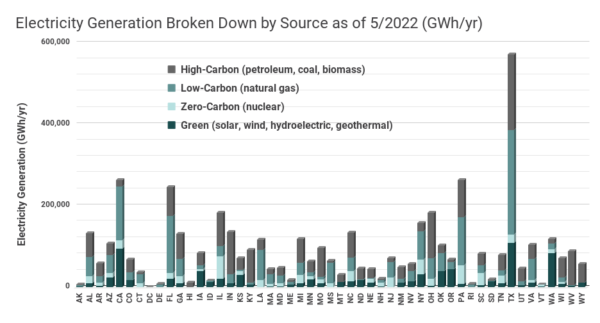
Image: LandGate
To calculate the electricity demand for the United States, both infrastructure electricity and land transportation data were incorporated into this study. According to an EIA study, on-road passenger transportation accounts for 62% of transportation energy use in the U.S., with the rest being freight transportation (19%), marine (12%), air (5%), and rail (2%).
Assuming that only land transportation (on-road passenger, freight, and rail) can be completely electrified, we took driving statistics from the U.S. Department of Transportation and estimated the average yearly car mileage per driver for each state, which ranges from 7,013 miles per year for the District of Columbia to 24,069 miles per year for Wyoming. Combined with the number of licensed drivers for each state, we derived the yearly mileage per state for on-road passengers.
Since EVs in the U.S. account for less than one percent of all vehicles and we are not modeling an increase in the number of drivers, we will assume for our calculations that all vehicles are petroleum-based. Using an average EV energy consumption of 350 Wh (Watthour) per mile, and with more modeling, we converted this to a total energy consumption to turn the entire passenger vehicle fleet, along with freight and rail transportation, to electric (See Figure 2.)
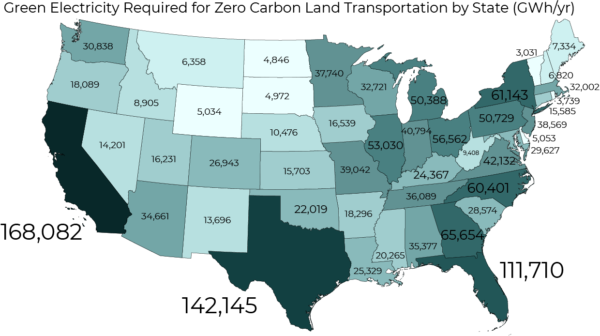
LandGate
Utility-scale generators in the United States currently generate around 4.7 million GWh per year, with 1.8 million GWh produced from high-carbon emission sources of energy and 1.6 million GWh from low-carbon emission natural gas. The electricity needed to make land transportation totally zero-carbon is estimated at 1.6 million GWh per year. To bring the current electricity production and land transportation to zero-carbon standards will require five million GWh per year of additional electricity generation from green energy. (Figure 3 and Figure 4 show the breakdown of this additional green electricity required for each state to have no carbon emissions.)
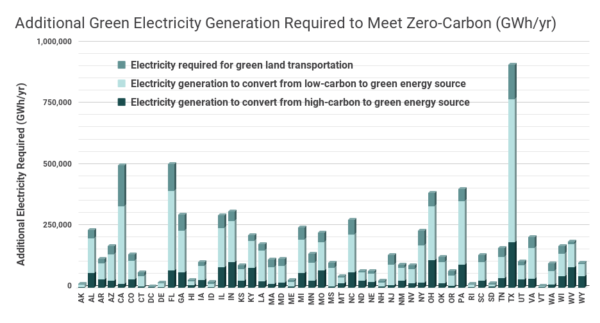
LandGate
A key question in determining how much land is needed is what source of green energy will be used to produce these five million GWh per year of additional electricity. Growing calls for removing hydroelectric dams combined with increasing droughts — such as the one at the Glen Canyon Dam in Arizona’s Lake Powell where water levels have dropped to a historic low — do not make new hydroelectric dams likely. Wind farms take more acreage than solar to produce the same electricity, but they allow use of the land.
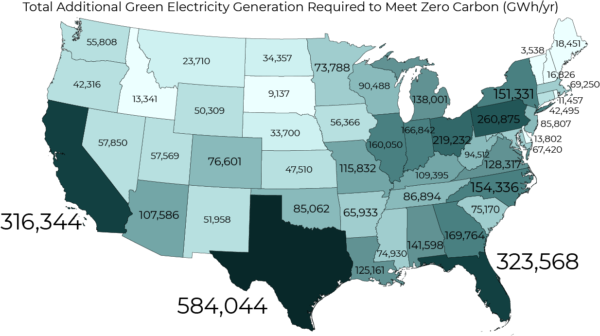
To simplify this analysis, we will assume that all the additional electricity from green energy sources will come from solar farms. Using the solar irradiance, topography, exclusion zones and buildable acreage specific to every state, we calculated the acreage required to generate this additional electricity on a per-state basis. (Figure 5)
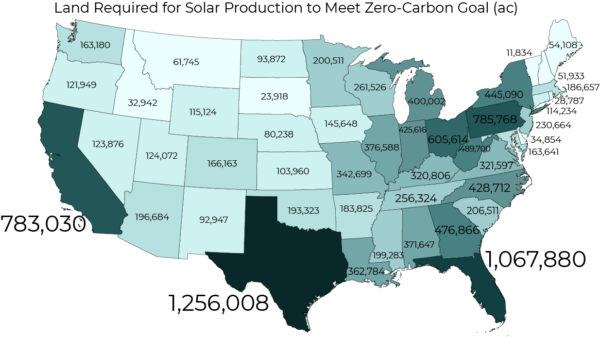
Solar farms in the U.S. built and being built to date currently occupy an estimated half million acres. Adding up the required additional acreage across all 50 states, we would need an additional 13 million acres of solar farms in the next decade to meet the zero-carbon goals, over 25 times more than what has been built to date (Figure 6.). Reaching this reality would also require additional energy storage and infrastructure like transmission lines, substations, and distribution lines, which could be roughly estimated at another 13 million acres. This Kentucky-size acreage required for green electricity production, transportation, and storage represents around one percent of the land in the continental United States.
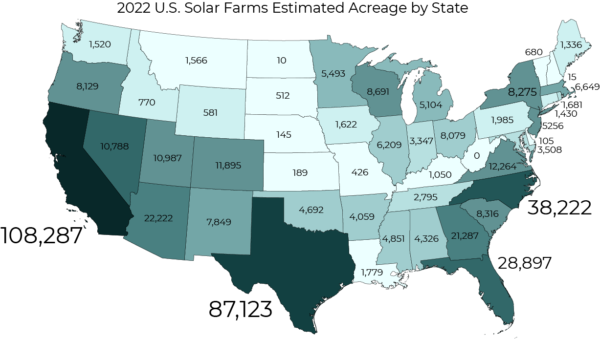
The first step in this energy transition is replacing the high-carbon energy sources: coal and fossil fuels. The next step will be replacing the low-carbon energy sources, like natural gas.
Although there’s no denying the substantial acreage that will be required for green energy production, we believe these zero-carbon goals can be met. Stakeholders across the spectrum are championing the cause, from government and climate advocates to an increasingly vocal contingent of investors who are focused on clean energy. With landowners also poised to benefit from renewable royalties or leases, all indicators are pointing to solar’s continued growth in the years ahead.
 Yoann Hispa is the CEO and Co-Founder of LandGate.
Yoann Hispa is the CEO and Co-Founder of LandGate.
The views and opinions expressed in this article are the author’s own, and do not necessarily reflect those held by pv magazine.
This content is protected by copyright and may not be reused. If you want to cooperate with us and would like to reuse some of our content, please contact: editors@pv-magazine.com.








DOE (Department of Energy)…if you’re listening : The perfect sun-drenched area is the former Nevada Nuclear Test site. Hundreds of square miles of slightly contaminated and access controlled land…just begging for a few Terra-watt size solar farms.
This helps to show that rooftop solar is a good option. It reduces the amount of utility scale solar and therefore, land, required for solar farms as well as reducing a significant portion of distribution lines and substations that require more land. When residential and commercial rooftop solar is installed with storage, it also makes electrical power more reliable since homes and businesses can continue receiving power when the grid goes down.
Dream on. Unless you stop earth from turning, sun only shines 40% of the useful day. And batteries can’t store what we need for the other 60%.
That’s like the people who said we could never put a man on the moon because it had never been done before, or like the guy who said, “Everything that can be invented has already been invented”. It’s discounting the relentless advance of technology. And it’s ignoring EXPONENTIAL growth of technology. Humans are not very good at predicting growth when it’s exponential. The human mind tends to think in linear terms and therefore gets blindsided over and over again by new developments coming at an ever increasing rate. Energy storage is one of those technologies that’s growing exponentially.
Parking lot structures would provide shaded parking. Floating panels would reduce evaporation and alge growth. Large dairies and other ag faculities that need acre plus sized barns would mostly welcome a power company installing a roof for solar panels that would provide dry storage for hay or equipment.
Yoann, thank you for the article & the analysis. I’m wondering on these follow-up questions & analysis:
How many acres of solar can we get from home rooftops? Do you know the breakdown of ALl solar installed today? I’m thinking home rooftops, public facility rooftops and parking lots, and then the larger scale solar fields. I’m wondering how long, & to what expenses, did it take to get where we are today? To get to the acreage you calculated, we could consider a scale-up version, of what we’ve done to date.
Really?! “To simplify this analysis, we will assume that all the additional electricity from green energy sources will come from solar farms.” … That is okay for a brain exercise, but this is a totally ridiculous analysis from a reality point of view. There are all the other questions presented so far, such as how much rooftop PV would reduce this figure … and Wind, etc. — that is all acreage that is not rational to include thus making the analysis bogus.
But the big issue is that you are creating a false concept of the future which will, as such things do, give some anti-green-energy nut a chance to cite your statistic to be anti PV. Congratulations on helping us fail at #RealClimateAction!
Please PV Mag, let’s stick to practical and real analysis, and leave the hypotheticals for nerds in a corner at a conferences. The world needs good leadership … not diversions into absurd anti-realities that will absolutely NEVER exist.
You have to investigate these sorts of hypotheticals to get a feel for the size of problem. The average price of utility-scale PV in the US was 95 cent/watt last year. This price is expected to steadily trend down to 75 cents/watt, 50 cents/watt and even lower. This will take us down into the 1 cent/kWh territory. Solar looks set to pull away from wind so far as price goes. I believe it will get down to 50% cheaper in the next 5 years. Maybe not in the Pacific North West but definitely in the Southwest/Southeast and probably even Texas. The incredible pace of improvement in utility-scale solar is simply amazing. I don’t know if you’ve noticed but there’s an arms race going on between the solar manufacturers to see who can build the biggest high-efficiency modules. Have you seen the 5B Maverick? Imagine if that catches on and First Solar starts shipping out seacans full of these accordion arrays – the direct installation costs could dip down below 1 cent/Watt.
https://www.youtube.com/watch?v=_yq-TiFEDgI&ab_channel=5B
I haven’t seen many forecasts for how much electricity it will take to electrify land transport but 5,000 TWh doesn’t sound outlandish. It works out to an average of 13.7 TWh per day. In a solar-dominated grid the bulk of this charging would need to be crammed into 8 to 12 hours of sunlight. This means the charge rate could get up as high as 1150 to 1750 GW per hour – this is 1.5 to 2.5 times the peak load on the entire US system (the summer peak when everyone is running their A/C). This may seem impossible for solar to do but consider the alternative. Let’s say we had a lot of wind that allowed us to spread the charging times over 16 to 20 hours – that’s still going to be a huge increase in system peak loading. We’re going to have to solve a huge distribution problem one way or another. PV has a lot more flexibility when it comes to where you deploy it so I wouldn’t entirely discount the idea of a system that’s heavily weighted towards PV.
When you do the modeling of high penetration RE grids the models generally select for wind because it’s historically been the cheaper resource. The mixes tend to have solar to wind ratios of 25/75 or 40/60 but there’s been a steady march towards higher solar ratios.
In mixes with higher percentages of wind you’re exposed to multi-day continental-sized low-pressure events which knock your wind production into the toilet. This drives the need for a considerable amount of stand-by gas generation (350ish GW) that only generates 200 TWh a year. Solar-dominated systems are less exposed to this extreme weather problem so hypothetically you may not need nearly as much gas backup. Solar-dominated grids should also be able to do V2G more often. I’m not saying that’s a good thing but it’s definitely an interesting thing.
I’m not saying we should try to do everything with solar but I wouldn’t be completely surprised if we start seeing mixes that push into solar to wind ratios of 70/30 or 80/20. At that point this analysis is a pretty good estimate for how much land we’ll need.
Around 33% of the US is desert. If we don’t quickly deploy RE all around the world we’re going to see more desertification. Shouldn’t we sacrifice some of our deserts to prevent the expansion of our deserts?
The idea that we can rooftop solar ourselves out of this problem is incompatible with reality. Between electrifying transportation, heating and process heat we’re going to need to triple electricity consumption. It’s abundantly clear that well over 90% of the solar is going to be utility-scale.
I still think residential and commercial rooftop solar will be a significant part of the RE mix. NREL estimates it could supply a terawatt in the US. And there are all the parking lots, irrigation canals, brownfields, etc too. I know there are a lot of hurdles but technology is rapidly changing. Who knows, maybe this will all become a moot point because of some unexpected breakthrough in fusion or fission nuclear power that makes a reactor economical and safe. But forgetting that, advances in PV cell efficiency may reduce the needed space by huge amounts which will also reduce the price by huge amounts in the coming decades.
China and India now produce more CO2 than the US does. Whatever the US does concerning green-energy won’t matter to the atmospheric rise of CO2 if China and India don’t comply. China and India have hundreds of millions of people to raise out of poverty. The governments of these countries know wind and solar power are non-continuous, energy dilute, expensive and unreliable. That’s why they will continue to use fossil fuels to raise their peoples out of poverty and the CO2 level will continue to rise. Look for China and India to resist any meaningful negotiations about decreasing CO2 emissions. Right now it’s a huge mistake for the US to spend hundreds of billions of dollars on large scale wind and solar power without knowing what China and India will do.